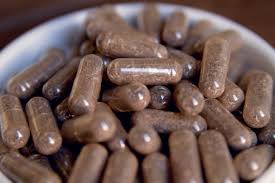
Have you heard of "placenta encapsulation"? While pregnant I read a bit about it, heard some from a doula I talked to, and read some "granola mama" blog posts on it.
But what is it and Why Do It?
The placenta is the organ that surrounds the fetus in the womb and allows for the exchange of nutrients, blood, and waste with the mother. It is expelled from the uterus after the birth of the child. The custom of consuming the placenta, or placentophagy, is centuries old, practiced most often in Chinese medicine. It is a controversial tradition that has been gaining traction in the United States for several decades, especially in the celebrity world with stars like January Jones and Alicia Silverstone giving eating the placenta a try. But are there truly benefits to the practice? How is it done? And what was my experience?
Background on the Practice
In China, mothers have engaged in placenta consumption for thousands of years. It was meant to help them regain their energy, stamina and boost milk supply.
While there is not a lot of research on its benefits, there actually is some science to eating the placenta… it contains oxytocin, a hormone that reduces pain and increases bonding with baby, it also contains thyroid stimulating hormones, interferon and prolactin, which can boost the immune system, energy, recovery and milk supply.
As it turn out, humans are one of the only mammals on earth who don’t eat their placentas after giving birth. Some researchers say that this is because eating the placenta offers a biological advantage, and critics argue that most mammals consume their placentas to hide traces of childbirth from predators in the wild.
There is very little scientific research done on its advantages, mostly the benefits reported are anecdotal, but one study did find that rats who consumed their placentas had higher pain thresholds, among other benefits.
How to Do It
Some people actually eat it raw (eeek!!). In rare cases they do right after birth.
Other people cook the placenta like they would any other organ meat, and eat it that way (eeek again!).
But the most popular option by far, is to encapsulate the placenta. This usually involves steaming the placenta, then drying it, grinding it, and placing it into pill form.
Why Do It? The Reported Benefits
Again, while these are anecdotal, the reported benefits are as follow:
- Increased release of the hormone oxytocin, which helps the uterus return to normal size and encourages bonding with the infant
- Increase in CRH, a stress-reducing hormone
- Decrease in post-partum depression levels
- Restoration of iron levels in the blood
- Increase in milk production
- Increased energy
Why I Did It and My Experience
Truth is I was just intrigued, and because it is just a capsule (so not as gross) I figured why not! My first post-partum wasn't necessarily "depressive" but there sure were a lot of tears, exhaustion, and recovery pain, so I decided to give it a try and see how it goes.
The results were great- (even my mother noticed!)- I was in great mood, high energy, good sleep (in between feedings) and very low stress. Wether this was because it was the second time around, labor was SO much easier than the first, and/or a placebo effect - I don't know and never will, but if you have suffered from depression or just think you'd be willing to try, I'd highly recommend it!
Sources:
- http://www.washingtonpost.com/national/health-science/some-mothers-see-health-benefits-in-eating-their-placenta-after-giving-birth/2012/04/02/gIQAVfgLrS_story.html
- http://en.wikipedia.org/wiki/Placentophagy
- http://americanpregnancy.org/first-year-of-life/placental-encapsulation/

 RSS Feed
RSS Feed